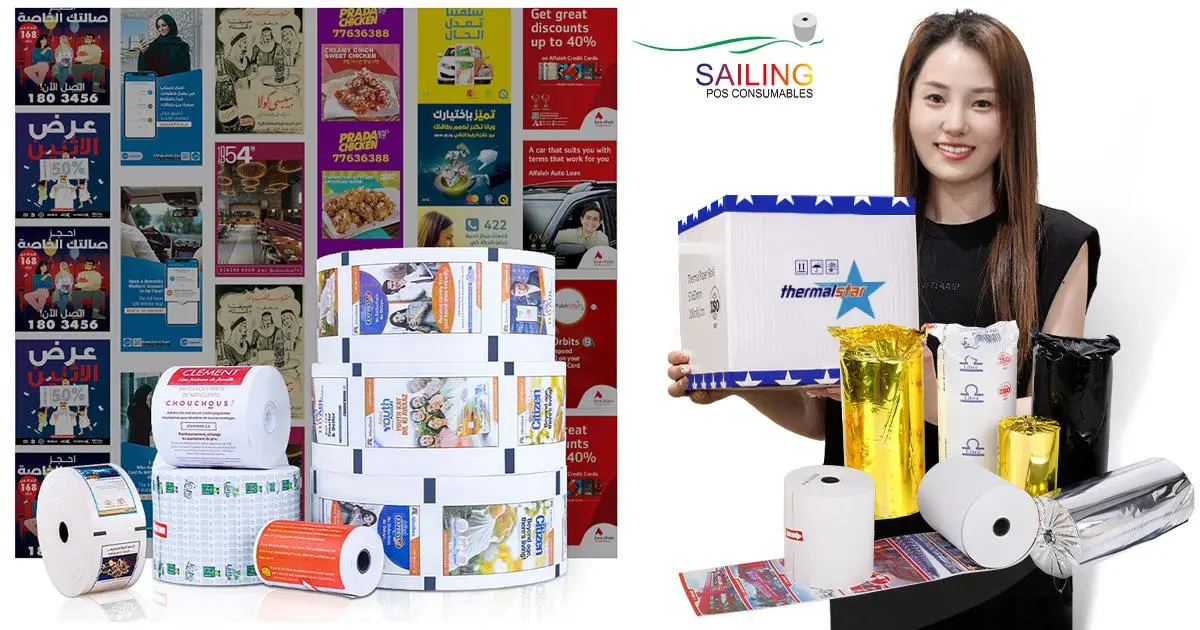In today’s fast-paced business environment, choosing the right kind of receipt paper is crucial for efficiency and client pleasure. The way payment processes are changing due to digitalisation makes it easier to understand the differences between thermal and traditional receipt paper.
Paper is available in a vast array of shapes and types. Most people learn to use printers and construction paper as early as kindergarten, but custom thermal receipt paper is different if your business produces receipts. We’ll examine various variations in this blog, emphasising their qualities and advantages.
What is Thermal Paper?
Thermal paper, also referred to as receipt printing paper, is a unique kind of paper that requires no ink since it changes colour as it gets heated.
Applying heat-sensitive compounds to a base paper creates this paper. The manufacturer’s specific combination of chemicals and colouring may vary. Heat causes the dye to react and change colour; it normally goes black, but with some coatings, it may also turn blue or red. In order to produce legible text, thermal printers use print heads that heat certain areas of paper.
As you may have discovered while attempting to scribble anything on a receipt, thermal paper has a flat surface that is excellent for printing but challenging to write on with a pen or pencil.
The dye appears when heated, so if you drag your fingernail over it, the friction may cause a black mark to emerge.
Cash registers, adding machines and credit card terminals often employ thermal paper. Depending on the device, it comes in different sizes. Additionally, since it does not need ink, you only need to change the paper roll rather than the ink cartridges.
What is Thermal Paper Used For?
Most receipts are printed on thermal paper. You are undoubtedly used to seeing a thermal receipt if you do not write your receipts by hand.
Credit card terminals, theatre tickets, movie tickets, ATM receipts, hospital records, price tags, shipping labels, barcode labels, and more all utilise thermal paper in addition to receipts.
What is Receipt Paper?
Thermal paper contains numerous layers to produce printed text. Here’s a quick summary:
- Substrate Layer: Typically composed of wood pulp, this layer consists only of paper.
- Base Layer: A mixture of gelatin, starches, and alkali salts, often referred to as the pre-coat layer. This layer protects the substrate layer and facilitates heat transfer through the paper. By triggering the dye, it evens out the surface of the paper and aids in the stability of the printed picture.
The layer known as the active coat is where the magic occurs. It has unique ingredients, including heat-sensitive pigments that change colour when heated. Colour developers and leuco dye crystals are its two primary parts. The colour developers and dye crystals react with heat to produce black markings on the paper.
Additionally, certain thermal papers contain an additional layer of protection that guards against UV radiation, oil, water, and other damage to the printed picture.
Thermal Paper and Receipt Paper Sizes
Businesses may select the thermal or receipt paper size that best fits their requirements from the sizes available. The most common sizes for thermal papers are 80 x 70, 80 x 80 mm, and 57 x 40 mm. Portable printers frequently use 57mm x 40mm paper, whereas printers use 80mm x 70mm and 80mm x 80mm paper.
While some organisations use 57mm x 70mm paper to conserve space, 76mm x 70mm is the most typical size for receipt paper in POS systems. The kind of POS system a company has requirements will determine the amount of receipt paper the company uses.
Selecting the appropriate size of receipt paper is crucial for the proper operation of your Point-of-Sale (POS) printer. Here’s how to choose the appropriate size:
- Width: Measure the width of the roll from side to side. 57mm, 76mm, and 80mm are common widths.
- Diameter: Measure the diameter of the roll from edge to edge, taking into account the spindle hole in the centre. Rolls with larger diameters are longer. For counter printers, standard sizes are 60, 70, and 80 mm; for mobile printers, standard sizes are 30 or 40 mm.
- Length: This is the total amount of paper that encircles the roll. Roll lengths range from 55 to 83 millimetres.
- Core Size: Rolling the paper around a tube has a core size, which is its diameter. 12.7mm is the most used core size.
Take paper thickness into account as well. Although thicker paper is more resilient, you may print fewer receipts on a single roll.
Using High-Quality Thermal and Receipt Papers Is Essential
| Feature | Thermal Paper | Receipt Paper |
| Purpose | Used in thermal printers for receipts and labels | Used in various printers for receipts, tickets, and labels |
| Printing Method | Heat-sensitive; no ink needed | Typically uses ink or toner |
| Coating | Contains a heat-sensitive coating | Usually plain paper, no special coating |
| Color Change | Changes color with heat (usually black) | Color depends on the ink or toner used |
| Surface | Slick surface; not easy to write on | Regular paper; can be written on with pen or pencil |
| Applications | Receipts, labels, tickets, ATM slips, etc. | Receipts, tickets, forms, etc. |
| Durability | Can fade over time when exposed to heat or light | Generally more durable and can last longer |
| Handling | Requires careful handling to avoid smudging | More resistant to handling marks or smudging |
Premium thermal and receipt paper should be used to ensure the information printed on the receipts is accurate and readable. Poor-quality papers may have smeared or blurry text and illustrations, which makes it challenging for readers to comprehend and read the content.
Thermal Paper
Composition:
A heat-sensitive layer is applied to a base paper to create custom thermal receipt paper. Usually, a mixture of dyes, developers, and other heat-sensitive compounds make up this layer.
Printing Mechanism:
Thermal print heads provide heat while printing on thermal paper. Text or images may be created on paper by heating the chemical coating and reacting with it without the toner or ink cartridges.
Uses:
Thermal paper finds widespread application in several industries due to its direct thermal printing technology. It helps label parking tickets, ATMs, fax machines, point-of-sale systems, and medical equipment.
Paper Receipt
Composition:
Paper used to print receipts falls into a larger category that covers a variety of paper kinds. Thermal, carbonless, or paper bond printing materials can be used, depending on the needs and preferences.
Printing Mechanism:
A range of printing methods can be supported by receipt paper, depending on the type of paper that is utilised. For instance, bond paper uses laser or inkjet technology, whereas thermal receipt paper uses direct thermal technology.
Applications:
In the retail, hotel, banking, and other commercial sectors, receipt paper creates transaction receipts. It makes it easier for businesses to maintain records of their transactions and provides customers with tangible proof of purchase.
Tips to Choose the Right Thermal Paper
Here are a few tips to pick the right thermal paper for your use.
Select the Appropriate Size
You must choose the thermal paper size that corresponds with your printer since it comes in different sizes. To begin with, ensure that the width of your printer and the thermal paper roll you are purchasing are the same. Take into account the roll’s length as well; longer rolls may print more receipts and last longer, making them more economical.
Verify the Calibre of the Paper
The quality of thermal paper varies. Better paper has a longer lifespan and a lower fading rate. Tear a sample of the paper and use a lighter to burn its back to determine the quality. After heating, the good thermal paper should have a continuous colour block and become black with a greenish tinge. If you want the print to endure longer, some rolls include a protective coating that helps stop fading.
Check Prices
Examine costs offered by various manufacturers and vendors. Even while it might be tempting to choose the least expensive alternative, be sure to take the paper’s quality into account as well. For you to receive the most value for your money, price and quality need to be well-balanced.
Using Your Fingernail, Scratch
Using your fingernail to make a scratch on paper will reveal whether or not it is thermal. A unique coating on thermal paper responds to heat. The heat from your nail will cause the paper to become black when you scrape it. Attempt to scuff the paper on both sides. It is thermal paper if it becomes black. It is just standard paper if not.
Examine and Touch the Surface of the Paper
Examine and touch the surface of the paper. In contrast to conventional paper, thermal paper is often glossy and smooth. However, keep in mind that not all ordinary sheets are glossy and smooth, so this approach is not always ideal.
Roasting Fire
Using a lighter to gently heat the paper’s back is another way to test thermal paper. It is probably thermal paper if the colour changes and then disappears.
Utilise a Thermal Printer to Test
Using a thermal printer is another reliable method of verification. Thermal printers do not need ink ribbons since they print straight onto thermal paper. A thermal printer will not print anything on ordinary paper.
In summary
The kind of receipt paper your company needs will depend on its requirements. Carbonless paper has the advantage of being easily able to create many copies, whereas thermal paper offers efficiency and cost advantages, particularly in high-volume retail situations. In Graphic Tickets & Systems, we’re experts in producing thermal and carbonless receipt sheets that meet your specifications.







Be First to Comment